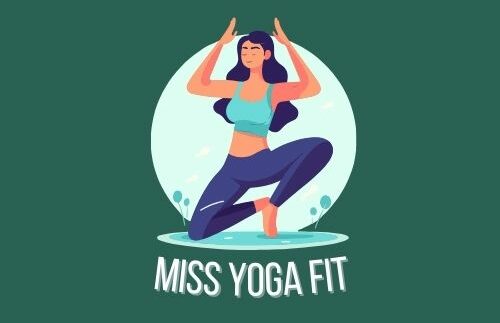If you’ve ever attended a yoga class, chances are you’ve heard the term “Vinyasa Flow.” It’s a popular style of yoga that emphasizes the connection between breath and movement, creating a moving meditation that can help practitioners find peace and balance. But what exactly is Vinyasa Flow Yoga, and how does it differ from other styles of yoga?
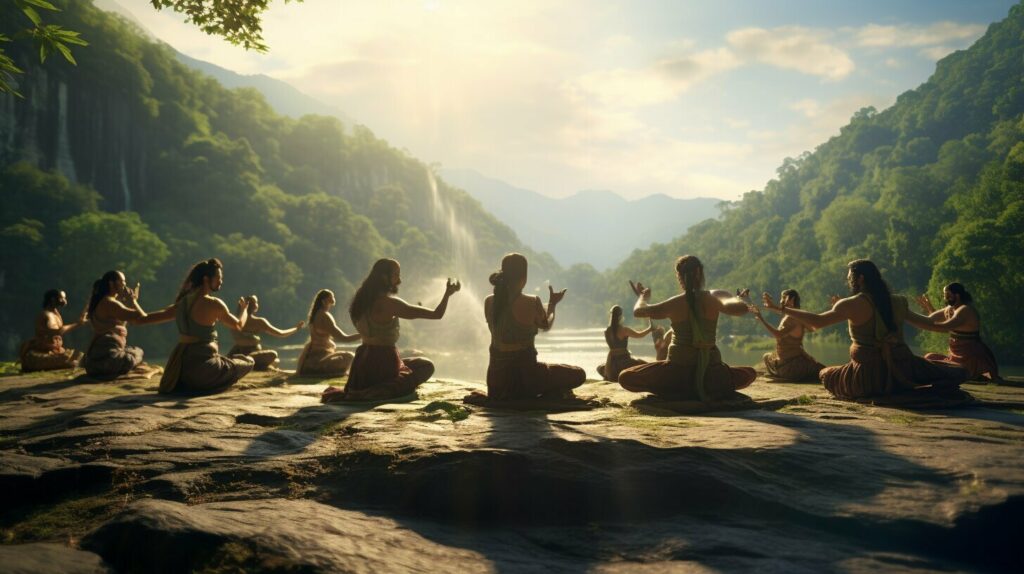
What is Vinyasa Flow Yoga
In short, Vinyasa Flow Yoga is a style of yoga that links movement with breath to create a flowing, dynamic practice. The word “vinyasa” means “to place in a special way,” and in Vinyasa Flow Yoga, this refers to the intentional sequencing of poses to create a seamless, almost dance-like flow. It’s a popular style of yoga for its accessibility and the wide range of physical and mental benefits it offers.
If you’re interested in learning more about Vinyasa Flow Yoga and how to incorporate it into your practice, read on for a comprehensive overview.
Key Takeaways:
- Vinyasa Flow Yoga is a style of yoga that emphasizes the connection between movement and breath.
- The word “vinyasa” means “to place in a special way,” and in Vinyasa Flow Yoga, this refers to the intentional sequencing of poses to create a flowing, dynamic practice.
- Vinyasa Flow Yoga is a popular style of yoga for its accessibility and the wide range of physical and mental benefits it offers.
Table of Contents
Origins of Vinyasa Flow Yoga
Vinyasa Flow Yoga is a contemporary style of yoga that is believed to have originated from the traditional Vinyasa style. The practice of Vinyasa can be traced back to the ancient texts of the Yoga Sutras, which date back to 200 BCE, making it a part of the ancient yoga tradition.
The term Vinyasa refers to a sequence of poses that are done in a specific order, synchronized with the breath. In Vinyasa Flow Yoga, this practice is taken to a new level by incorporating flowing movements and incorporating various yoga poses into a seamless sequence.
The origins of Vinyasa Flow Yoga, as we know it today, are credited to several influential yoga teachers, including Tirumalai Krishnamacharya, K. Pattabhi Jois, and Beryl Bender Birch. These teachers were instrumental in evolving Vinyasa Yoga into the dynamic and flowing practice that we know and love today.
One of the most significant contributions to the evolution of Vinyasa Flow Yoga was made by K. Pattabhi Jois, who created the dynamic series of poses known as Ashtanga Yoga. Ashtanga Yoga is a set sequence of poses that are done in a specific order, with each movement linked to the breath.
Beryl Bender Birch, a student of Jois, further developed the practice of Ashtanga Yoga by incorporating flowing movements and creating the style of Vinyasa Flow Yoga that we know today.
The Evolution of Vinyasa Flow Yoga
Over the years, Vinyasa Flow Yoga has continued to evolve and grow, with new variations and styles emerging. One such style is Power Yoga, which is a more vigorous and athletic form of Vinyasa Flow Yoga that emphasizes building strength and endurance.
Today, Vinyasa Flow Yoga remains one of the most popular styles of yoga around the world. Its flowing movements and emphasis on breath and mindfulness make it a favorite among practitioners of all skill levels.
Philosophy and Principles of Vinyasa Flow Yoga
At the heart of Vinyasa Flow Yoga lies a set of guiding principles that transcend the physical practice of yoga. The philosophy behind this style of yoga emphasizes the interconnectedness of breath, movement, and mindfulness. By synchronizing breath with movement, Vinyasa Flow Yoga provides a powerful tool for cultivating present-moment awareness and inner peace.
One of the key principles of Vinyasa Flow Yoga is the idea of flow. This refers to the smooth and continuous movement between poses, with an emphasis on creating a seamless transition between each asana. The flowing nature of this style of yoga is what sets it apart from other practices and helps to create a dynamic and engaging experience for practitioners.
Another important aspect of Vinyasa Flow Yoga is the focus on the breath. Pranayama, or breath control, is an integral part of this practice, with practitioners encouraged to deepen and elongate their breath in sync with their movements.
This not only helps to enhance physical performance and endurance but also serves as a powerful way to calm the mind and reduce stress and anxiety.
The Five Vinyasa Principles
| Principle | Description |
|---|---|
| 1. Breath | The breath is the foundation of the practice, and it is important to cultivate awareness and control of the breath throughout the practice. |
| 2.Movement | Movement is coordinated with the breath, creating a flow between poses. |
| 3. Drishti | Drishti refers to a focal point or gaze, which helps to improve concentration and balance. |
| 4. Bandhas | Bandhas are internal muscular locks that help to deepen the breath and create stability in the body. |
| 5. Vinyasa | Vinyasa refers to the seamless transition between poses, facilitated by the breath and movement. |
Vinyasa Flow Yoga also places a strong emphasis on mindfulness, encouraging practitioners to be fully present in their practice. By cultivating awareness and non-judgmental observation, Vinyasa Flow Yoga can help practitioners to develop a deeper connection with their body and breath, as well as a greater sense of inner peace and contentment.
Overall, the philosophy and principles of Vinyasa Flow Yoga serve as a powerful foundation for this dynamic and engaging practice. By emphasizing the interconnectedness of breath, movement, and mindfulness, Vinyasa Flow Yoga provides a unique and transformative way to cultivate physical strength, mental focus, and emotional well-being.

Flowing Poses and Sequences in Vinyasa Flow Yoga
In Vinyasa Flow Yoga, the practice of linking breath with movement is emphasized, creating a fluid and dynamic sequence of poses. These sequences can vary depending on the teacher, but they typically include a combination of standing, seated, and balancing poses.
One of the most common sequences in Vinyasa Flow Yoga is the Sun Salutation, or Surya Namaskar. This sequence of poses is performed in a continuous flow, synchronizing breath with movements such as forward folds, upward-facing dog, and downward-facing dog. The Sun Salutation is repeated several times at the beginning of Vinyasa Flow classes as a warming-up exercise.
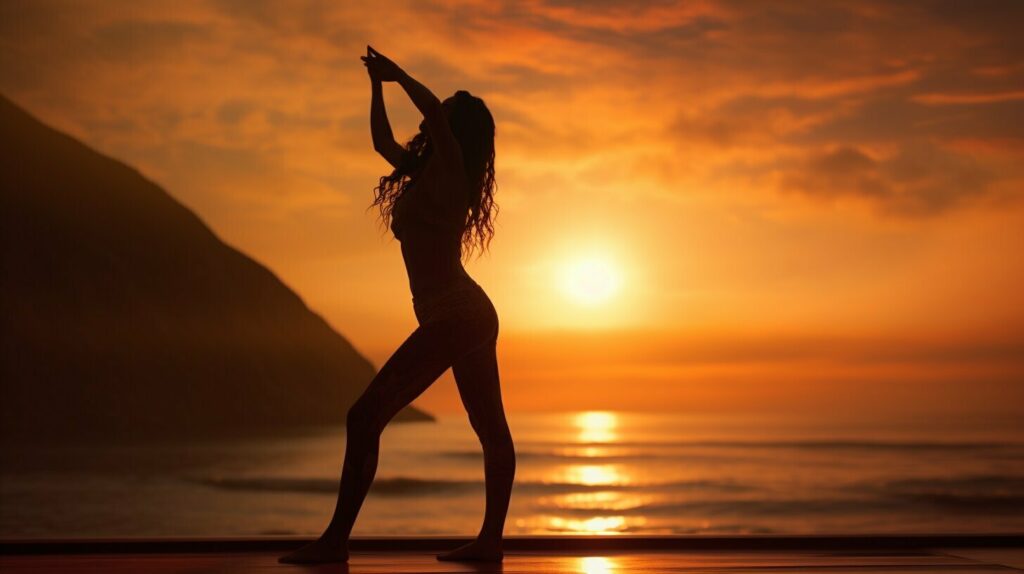
The transitions between poses are just as important as the poses themselves in Vinyasa Flow Yoga. When moving from one pose to another, it is essential to maintain the integrity of the breath and movement connection, creating a seamless flow between poses.
Here are some common poses and sequences that you may encounter in a Vinyasa Flow class:
| Poses | Description |
|---|---|
| Downward-Facing Dog | A pose that stretches the hamstrings, calves, and spine. The hands and feet are grounded, and the hips are lifted to create an inverted V-shape. |
| Warrior II | A standing pose that strengthens the legs and core, while also stretching the hips and shoulders. The arms are extended, and the gaze is towards the front hand. |
| Tree Pose | A balancing pose that improves focus, stability, and flexibility. The foot is placed on the opposite thigh, and the hands are brought to the heart center. |
It is essential to listen to and communicate with your body during your Vinyasa Flow practice. Don’t hesitate to modify the poses to suit your needs and skill level, and take breaks whenever necessary.
Remember, the practice of Vinyasa Flow Yoga is not about achieving perfection, but rather about connecting with your breath, body, and mind in a meaningful way.
Benefits of Vinyasa Flow Yoga
Vinyasa Flow Yoga offers a wide range of benefits for both the body and mind. Whether you are looking to increase your physical strength and flexibility or cultivate a greater sense of mental and emotional well-being, regular practice of Vinyasa Flow Yoga can help you achieve your goals.
Physical Benefits
Vinyasa Flow Yoga is a dynamic and challenging form of yoga that works to strengthen and tone the entire body. By moving through a sequence of flowing poses, practitioners can increase their flexibility, improve their balance, and build muscle mass. Additionally, many poses in Vinyasa Flow Yoga are weight-bearing, which helps to improve bone density and prevent osteoporosis.
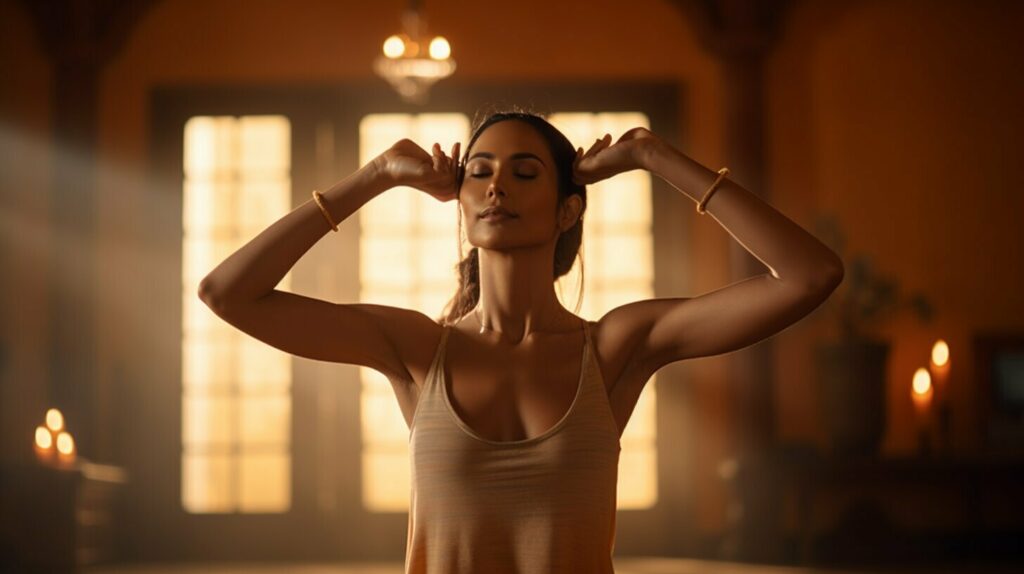
Mental and Emotional Benefits
Vinyasa Flow Yoga is not just a physical practice, but also a mental and emotional one. By focusing on the breath and moving mindfully through each pose, practitioners can cultivate a greater sense of mindfulness and awareness in the present moment.
This can help to reduce stress, anxiety, and depression, and improve overall mental well-being. Regular practice of Vinyasa Flow Yoga can also help to increase self-awareness, promote self-love and acceptance, and improve overall confidence and self-esteem.
Flexibility and Strength
One of the most significant benefits of Vinyasa Flow Yoga is the combination of increased flexibility and strength it provides. Practitioners can gradually develop greater range of motion and flexibility in their joints and muscles by stretching and holding poses.
Additionally, the dynamic movements and weight-bearing poses in Vinyasa Flow Yoga also help to build strength and muscle mass, leading to a toned and more defined physique.
Overall, the physical, mental, and emotional benefits of Vinyasa Flow Yoga are numerous and wide-ranging. Whether you are a seasoned yogi or a beginner just starting out, incorporating Vinyasa Flow Yoga into your regular practice can help you achieve greater health and well-being in all areas of your life.
Breath and Awareness in Vinyasa Flow Yoga
In Vinyasa Flow Yoga, breath and awareness play a central role in the practice. The term “Vinyasa” is derived from the Sanskrit root “nyasa” which means “to place,” and “vi,” which means “in a special way.” This highlights the importance of the connection between breath and movement, with each pose flowing smoothly and intentionally into the next.
Pranayama, or breath control, is an essential component of Vinyasa Flow Yoga. Practitioners are encouraged to use specific breathing techniques to enhance the mind-body connection and cultivate a sense of calm and presence.
One common technique is Ujjayi Pranayama, where the breath is deepened and lengthened, creating a soft, rhythmic sound in the throat.
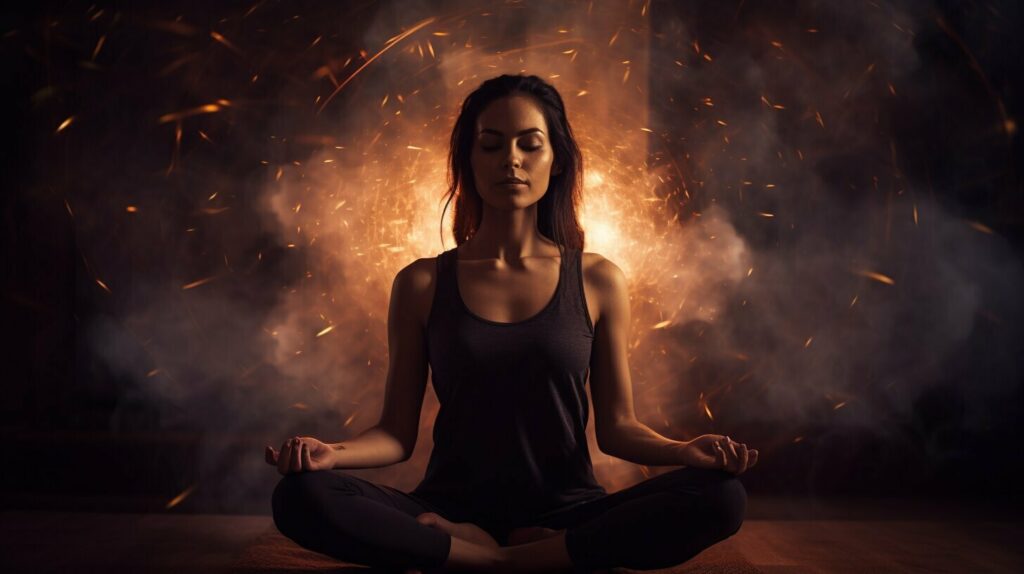
Mindfulness is also a key element of Vinyasa Flow Yoga. By focusing on the present moment and the sensations of the body, practitioners can deepen their awareness and create a sense of inner peace. This can be particularly beneficial for reducing stress and anxiety.
Incorporating breath and awareness into your Vinyasa Flow practice can greatly enhance its benefits. By cultivating mindfulness and pranayama techniques, you can deepen your connection to your body and breath, creating a sense of harmony and balance.
Modifications and Variations in Vinyasa Flow Yoga
In Vinyasa Flow Yoga, there are modifications and variations available to make the practice accessible to practitioners of all levels. Whether you’re a beginner or an advanced practitioner, modifications and variations allow you to tailor the practice to your specific needs and abilities.
If you’re new to Vinyasa Flow Yoga, it’s important to start with beginner-friendly modifications to avoid injury and build a strong foundation.
For example, instead of holding a full plank pose, you can modify by lowering your knees to the ground for a half plank. This modification still engages the core and upper body muscles but with less strain on the wrists and shoulders.
As you progress in your practice, you can begin to incorporate more advanced options and variations. For example, you can add arm balances or inversions to your practice to challenge yourself and build strength and confidence.
Modifications and Variations Table
| Level | Modifications | Variations |
|---|---|---|
| Beginner | Half plank instead of full plank | Supported headstand with a wall |
| Intermediate | Using blocks for balance in standing poses | Crow pose or side plank with extended leg |
| Advanced | Handstand prep drills | Full wheel pose or scorpion pose |
It’s important to remember that modifications and variations are not a sign of weakness, but rather a way to personalize your practice and make it work for you. Listen to your body and don’t push yourself beyond your limits.
When practicing in a group class, don’t hesitate to ask your instructor for modifications or variations. They are there to support and guide you on your yoga journey. With practice, you’ll find modifications and variations that suit you and help you progress in your practice.
In the next section, we will discuss how to incorporate Vinyasa Flow Yoga into your home practice with tips on creating a suitable environment and using props effectively.
Practicing Vinyasa Flow Yoga at Home
If you’re looking to incorporate Vinyasa Flow Yoga into your home practice, there are a few things to keep in mind to ensure a safe and effective practice.
First, create a personal space that is free from distractions and allows you to move freely. This can be a dedicated yoga room or simply a cleared-out area in your living space.
Next, gather any props that you may need, such as blocks, straps, or blankets, to support your practice and enhance your alignment.
| Prop | Use |
|---|---|
| Blocks | Provide support and stability in standing and seated poses |
| Straps | Help extend reach and deepen stretches in seated and standing poses |
| Blankets | Provide cushioning and support in seated poses and relaxation |
When practicing at home, it’s important to listen to your body and honor your limits. Take breaks when needed and modify poses as necessary to prevent injury.
If you need guidance or support, consider accessing virtual classes led by experienced instructors. Many studios and teachers offer online classes that you can access from the comfort of your own home.
Remember that a home practice can be just as effective as attending a class in person. With the right mindset and tools in place, you can create a fulfilling and transformative Vinyasa Flow Yoga practice in your own personal space.
Alternatives to Vinyasa Flow Yoga?
If you feel that this particular yoga style may not align with your current stage in your yoga journey, allow me to introduce you to some alternative yoga styles that I believe will better suit your yoga goals. I encourage you to explore them – they might be just what you’re looking for!
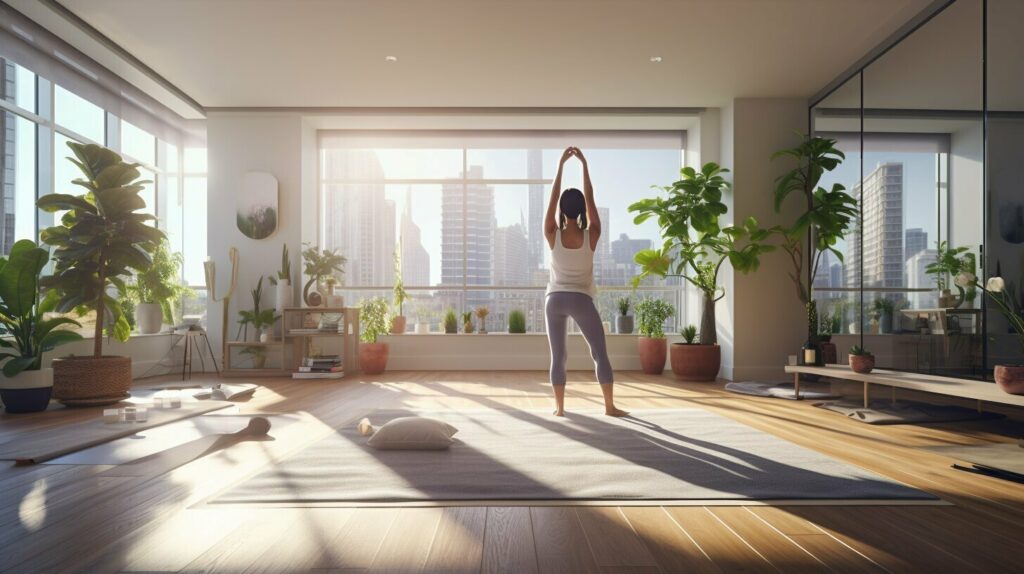
Conclusion
Overall, we hope this article has provided you with a comprehensive understanding of Vinyasa Flow Yoga.
In summary, Vinyasa Flow Yoga is a dynamic practice that emphasizes the connection between breath and movement, with a focus on cultivating mindfulness and present moment awareness throughout the practice. Its flowing nature and emphasis on smooth transitions make it a popular choice for many, with a wide range of physical and mental benefits, including increased flexibility, strength, and improved mental focus and emotional well-being.
As we conclude, we encourage you to explore Vinyasa Flow Yoga further, whether at a studio or from the comfort of your own home. By incorporating this practice into your routine, you can experience the transformative power of Vinyasa Flow Yoga firsthand.
Thank you for reading, and we hope to see you on the mat soon!
FAQ
What is Vinyasa Flow Yoga?
Vinyasa Flow Yoga is a dynamic style of yoga that involves synchronizing breath with movement. It is characterized by flowing sequences of poses that create a continuous flow of energy throughout the practice.
What are the origins of Vinyasa Flow Yoga?
Vinyasa Flow Yoga has its roots in the traditional Vinyasa style of yoga. Over time, it has evolved to incorporate elements from various yoga traditions, creating a unique and dynamic practice.
What are the philosophy and principles of Vinyasa Flow Yoga?
Vinyasa Flow Yoga emphasizes the importance of synchronizing breath with movement and cultivating mindfulness throughout the practice. It encourages practitioners to stay present and connected to their bodies and breath.
What are the flowing poses and sequences in Vinyasa Flow Yoga?
Vinyasa Flow Yoga utilizes a variety of poses and sequences to create a continuous flow of movement. Common poses include Downward Dog, Warrior, and Plank, while Sun Salutations are often used as a foundational sequence.
What are the benefits of Vinyasa Flow Yoga?
Vinyasa Flow Yoga offers numerous benefits for both the body and mind. It can increase flexibility and strength, improve mental focus and clarity, reduce stress, and promote overall physical and emotional well-being.
How does breath and awareness play a role in Vinyasa Flow Yoga?
Breath and awareness are fundamental in Vinyasa Flow Yoga. Practitioners are encouraged to focus on their breath, using it as a guide for movement and cultivating a sense of presence and mindfulness in the practice.
Are there modifications and variations available in Vinyasa Flow Yoga?
Yes, Vinyasa Flow Yoga offers modifications and variations to accommodate practitioners of different skill levels. Beginners can opt for gentler variations, while advanced practitioners can explore more challenging poses and transitions.
How can I practice Vinyasa Flow Yoga at home?
To practice Vinyasa Flow Yoga at home, create a dedicated space, gather any necessary props, and consider accessing virtual classes or following online tutorials for guidance and inspiration.
Magda Felcio, a certified Vinyasa Flow Yoga teacher in Brazil, is deeply passionate about the grace and transformation this practice offers. With a commitment to empowering her students, she creates harmonious and flowing sequences that focus on alignment and mindfulness.
